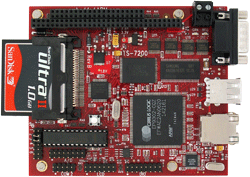

| Evan Gates | Juan Lasheras | Max Salley |
| (egates) | (jlashera) | (msalley) |
Placing WiFi access points ("arrays") requires a site survey. Most of the time the guess work involved in the survey, along with the repetition, makes the process long and tedious. This project aims to simplify the process by introducing embedded systems ("tags") which will dynamically monitor and report the status of an array's signal as it is adjusted, for faster site surveys.
This project is motivated by Xirrus' concept for a faster site surveying method.
There are no competitors; there are no products designed for this functionality.
Hardware: (please follow the links to the vendor's sites)|
TS-7200 Board (8mb) + Dev Kit |
Sparklan USB 802.11a/b/g/n Adapter |

|

|
| Part Number | Description | Price |
| TS-7200-32-8F | TS-7200 Single Board Computer (SBC) with 32 MB RAM and 8 MB Flash | $149 |
| KIT-7200 | Development Kit with 1GB Debian Compact Flash, regulated DC power supply, all needed cables, USB-CF adapter, utility CD with SBC resources, and printed documentation (TS-7200 SBC not included) | $120 |
| WUBR505N-S0 | SparkLAN WUBR-505 Wireless-N 802.11abgn draft 2.0 dual band 2T/3R USB Adapter (Ralink RT2870) | $54.95 |
USE CASES (INTERACTION DIAGRAMS)
[Unit has no use cases besides trivial on/off interaction]
In general lost packets will be due to collisions and are not a big deal. They should resolve themselves the next time they are sent due to the random backoff intervals. If a tag dies during the test we will use the last valid data received from it, and it will be replaced for the next round of testing. Each round of testing should only last a few seconds and it will not be hard to repeat after replacing the dead tag.
Gathered wireless statistics using a tag as well as a consumer wifi enabled product (Apple Macbook). Testing was intended to reveal whether the tag acts as a good sensor by providing readings representative of real-world usage
High correlation between the tag and a normal consumer product
shows that the tag can function as a useful sensor:
mid_semester_demo.{odp,pdf,ppt}
testing.{odp,pdf, ppt}